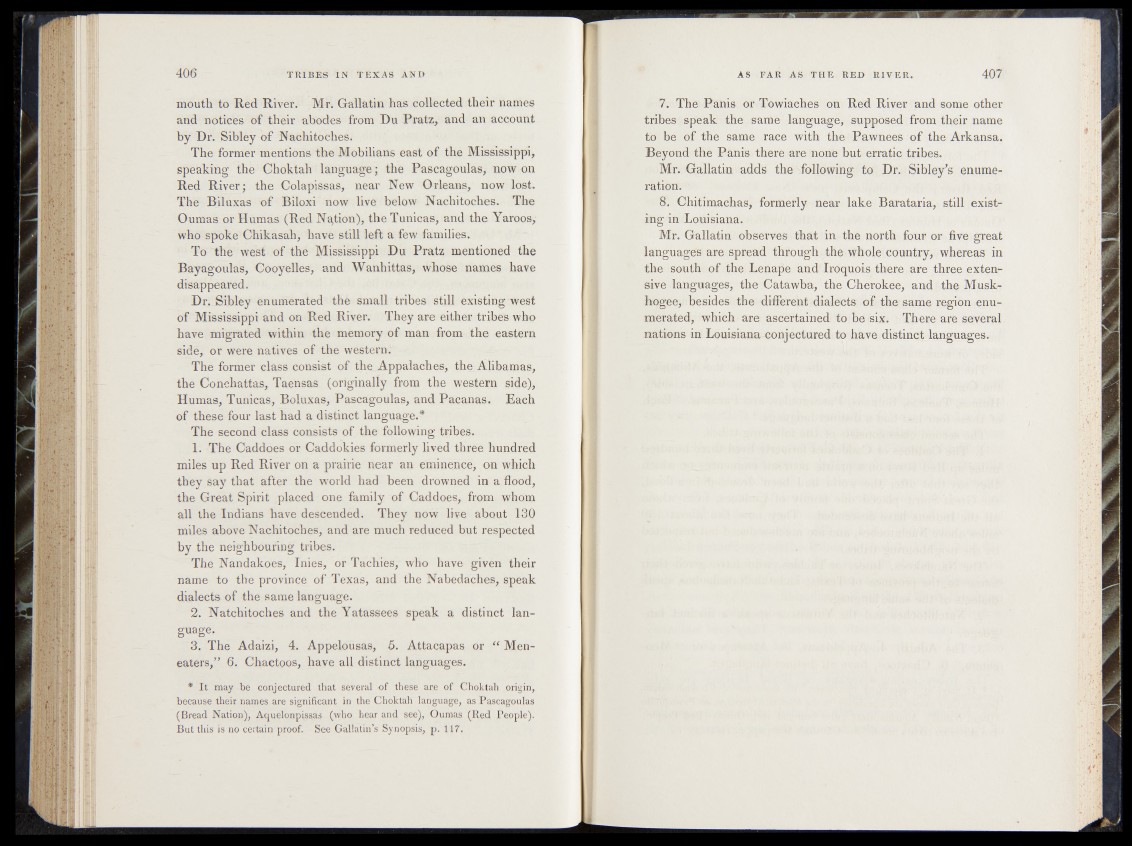
mouth to Red River. Mr. Gallatin has collected their names
and notices of their abodes from Du Pratz, and an account
by Dr. Sibley of Nachitoches.
The former mentions the Mobilians east of the Mississippi,
speaking the Choktah language; the Pascagoulas, now on
Red River; the Colapissas, near New Orleans, now lost.
The Biluxas of Biloxi now live below Nachitoches. The
Oumas or Hum as (Red Nation), the Tunicas, and the Yaroos,
who spoke Chikasah, have still left a few families.
To the west of the Mississippi Du Pratz mentioned the
Bayagoulas, Cooyelles, and Wanhittas, whose names have
disappeared.
Dr.Sibley enumerated the small tribes still existing west
of Mississippi and on Red River. They are either tribes who
have migrated within the memory of man from the eastern
side, or were natives of the westefni' -
The former class consist of the Appalaches, the Alibamas,
the Conchattas, Taensas (originally from the western side),
Humas, Tunicas, Boluxas, Pascagoulas, and Pacanas. Each
of these four last had a distinct language.*
The second class consists of the following tribes.
1. The Caddoes or Gaddokies formerly lived three hundred
miles up Red River on a prairie near an eminence, on which
they say that after the world had been drowned in a flood,
the Great Spirit placed one family of Caddoes, from whom
all the Indians have descended. They now live about ISO
miles above Nachitoches, and are much reduced but respected
by the neighbouring tribes.
The Nandakoes, InieS, or Tachies, who have given their
name to the province of Texas, and the Nabedaches, speak
dialects of the same language.
2. Natchitoches and the Yatassees speak a distinct language.
3. The Adaizi, 4. Appelousas, 5. Attacapas or “ Men-
eaters,” 6. Chactpos, have all distinct languages.
* It may be conjectured that several of these are of Choktah origin,
because their names are significant in the Choktah language, as Pascagoulas
(Bread Nation), Aquelonpissas (who hear and see), Oumas (Red People).
But this is no certain proof. See Gallatin’s Synopsis, p. 117.
7. The Panis or Towiaches Red River and some other
tribes - speak the same language, supposed from their name
to be of the same race with tjae”’ Pawnees of the Arkansa.
Beyond the Panis there are none but erratic tribes.
Mr. Gallatin adds the ^following to Dr. - Sibley’s enumeration.
•
Chitimachas, formerly near lake Barataria, still existing
in Louisiana.
Mr. Gallatin observes that in the north four or five great
languages are spread through the whole country, whereas in
the south of the Lenape and Iroquois there are three extensive
languages, the Catawba, the. Cherokee, and the Musk??
hogee, besides- the differentiddafects of the same region enumerated,
which are ascertained to be six. There are several
nations in Louisiana conjectured to have distinct languages.